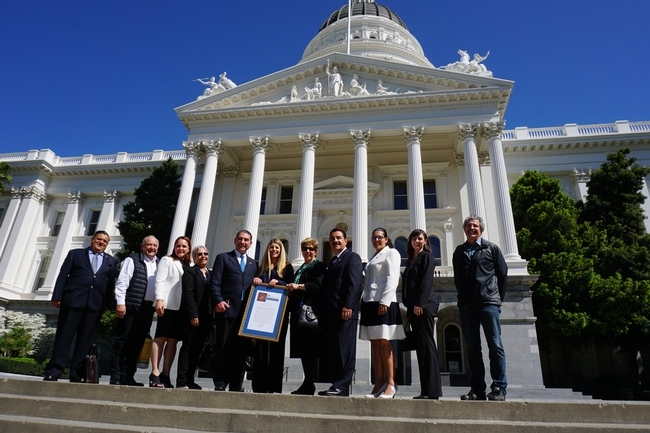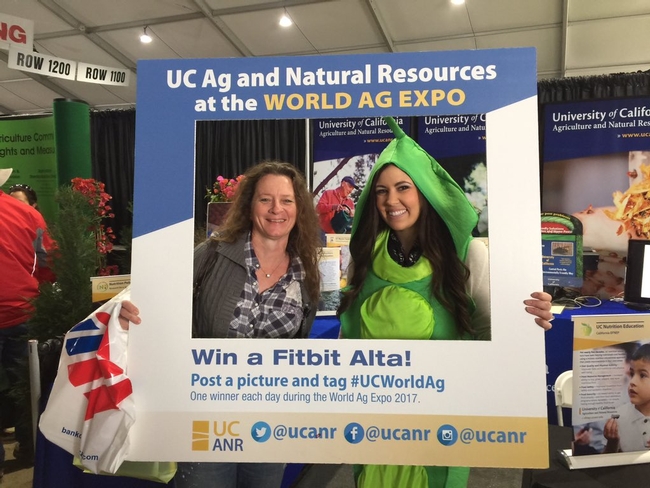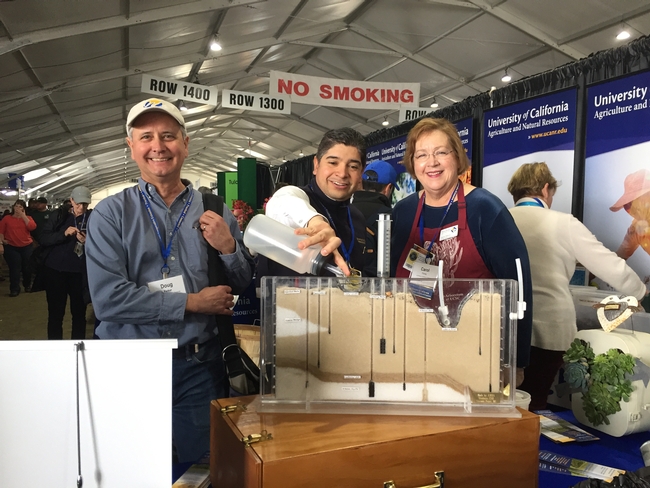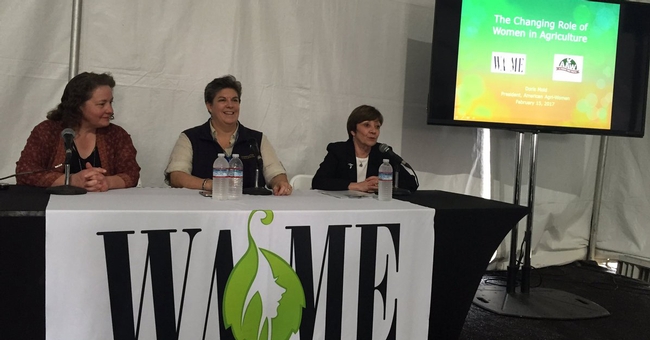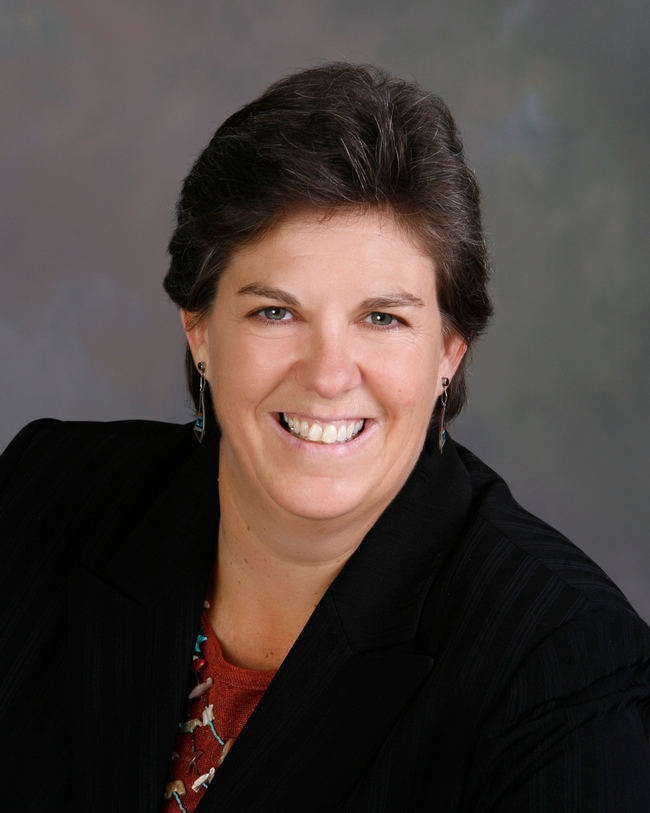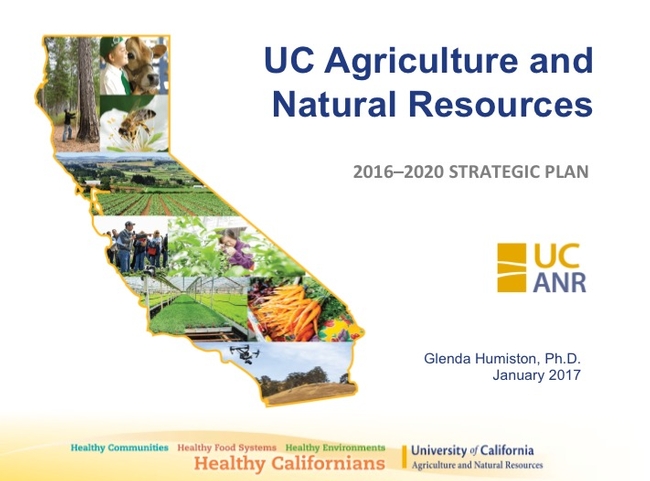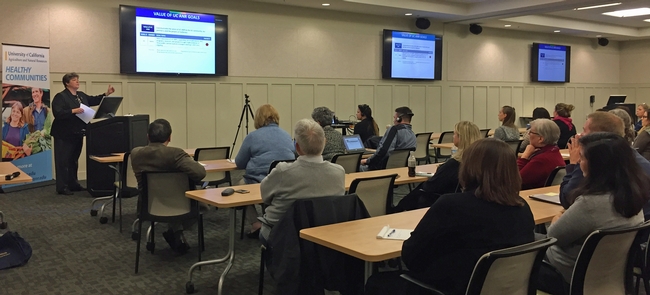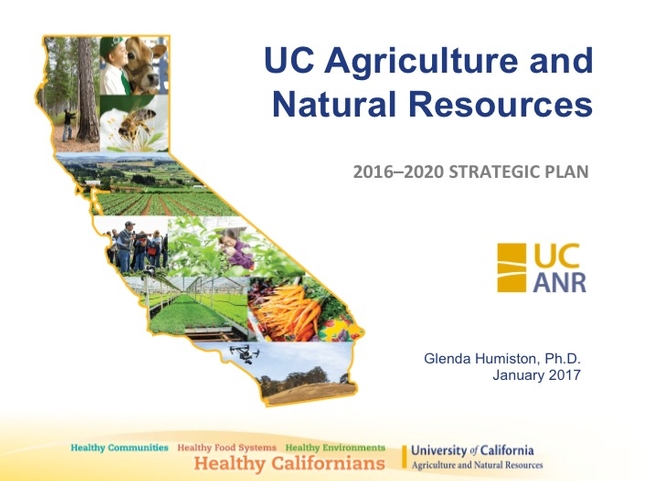Posts Tagged: Lupita Fábregas
Sen. Hueso honors UC 4-H program in Mexicali
California State Senator Ben Hueso honored California and Baja California 4-H with a resolution in the State Senate April 2 to recognize the cross-border team that established a 4-H Club in Mexicali, Baja Mexico, in January 2017.
The event, held in the Senate Chambers, was attended by Manuel Vallodolid Seamaduras, secretary of Agriculture Development in the State of Baja California, Mexico (Secretaría de Desarrollo Agropecuario del Estado de México - SEDAGRO); Hortencia Medellin Acosta, director of Rural Entrepreneurship, Mexicali, Baja California; Carlos Orozco Riesgo, member of the UC ANR 4-H Multicultural and Community Engagement Advisory Committee and former undersecretary of SEDAGRO; Belem Avendaño Ruiz, director of Inspection, health and safety SEDAGRO; Guillermo Gonzalez Rubio, director of the Livestock Health Department SEDAGRO; Agustin Manuel Velazquez Bustamante, legal advisor SEDAGRO; Mark Bell, vice provost of Strategic Initiatives and Statewide Programs; Shannon Horrillo, 4-H Youth Development Program director; Lupita Fabregas, 4-H Youth Development assistant director for diversity and expansion; and Claudia Diaz Carrasco, 4-H Youth Development advisor in Riverside and San Bernardino counties.
Last year, UC ANR Vice President Glenda Humiston signed a memorandum of understanding with Baja California Secretary of Agriculture Development Manuel Vallodolid Seamanduras to offer UC's 4-H expertise to youth south of the border. The agreement increases the academic, scientific, technological and cultural cooperation that are part of UC President Janet Napolitano's Mexico Initiative.
Hueso's resolution attests to the value of building relationships as a means of cooperative engagement between Mexico and California on shared concerns, such as drought and global climate change. The resolution notes that the creation of a 4-H Club in Mexicali is an inspiring reminder that the need for education doesn't stop at the border.
Hueso represents the 40th District, which includes parts of San Diego County and all of Imperial County, running along the entire border between California and Mexico.
ANR participates in World Ag Expo
The 50th World Agricultural Expo was held Feb. 14-16, 2017, in Tulare. The three-day show was attended by 105,780 people representing 43 states and 71 countries, according to its website. UC ANR participated by hosting a newsmakers event for journalists and sponsoring four booths displaying information about the division's array of research and programs.
At the booths, 4-H members and UC ANR scientists greeted visitors and answered questions. Visitors were invited to take a picture with a UC ANR frame and post it to social media with the hashtag #UCWorldAg to be entered in a contest to win a FitBit.
On the first day of the show, reporters were invited to meet UC ANR scientists, who gave 3-minute descriptions of their research. Rose Hayden-Smith, editor of the UC Food Observer blog, was the emcee. The speakers were as follows:
- Mary Lu Arpaia, UC Cooperative Extension horticulturist, UC Riverside, based at the Kearney REC in Parlier,avocadoes
- Khaled Bali, UCCE irrigation water management specialist, based at KREC, automated irrigation systems
- Peggy Lemaux, UCCE plant genetics specialist, UC Berkeley, and Jeff Dahlberg, KREC director and UCCE specialist, plant breeding and genetics, $12.3 million study on sorghum
- Lupita Fábregas, UCCE 4-H Youth Development advisor and assistant director for diversity and expansion, outreach to Latino communities
- Maggi Kelly, UCCE specialist and director of the UC Statewide Informatics and Geographic Information Systems program, UC Berkeley, research using drones
- Doug Parker, director, UC California Institute for Water Resources, drought
- Alireza Pourreza, UCCE agricultural engineering advisor, based at KREC, early detection of huanglongbing disease in citrus
- Leslie Roche, UCCE rangeland management specialist, UC Davis, drought management on rangeland
- Samuel Sandoval Solis, UCCE specialist in water resources, UC Davis, groundwater management
UC ANR and UC Food Observer live-streamed the talks on Facebook Live and on Twitter via Periscope. UC Food Observer's Facebook video of the event has been viewed nearly 5,000 times.
On the second day of the expo, a seminar on the changing role of women in agriculture was presented by VP Glenda Humiston, CDFA secretary Karen Ross and president of American AgriWomen Doris Mold. The speakers noted that women have always been involved in agriculture, but cultural bias often left them feeling that their role was inferior to the roles of male family members. The USDA's next census of agriculture will have questions designed to count women as industry workers even if they might consider their husbands or fathers to be the primary operators of the farm.
Humiston told the audience there are many career opportunities for women in agriculture, not just on the farm. She encouraged the young women and girls in the audience to look for opportunities in allied industries. For career advancement, women can join professional organizations and serve on committees, take advantage of training programs and run for leadership positions.
The panelists suggested that women also identify mentors — both men and women — who can help steer young professional women into successful agricultural careers.
ANR invites proposals for competitive grants, introduces new grant opportunities
Wendy Powers, associate vice president, announced the request for proposals for ANR's 2017 competitive grants program, which can be found at http://ucanr.edu/compgrants2017.
In addition to releasing ANR's competitive grants call, she shared information on a couple of newly developed funding opportunities: “high risk/high reward grants program” and “opportunity grants program.” Below are descriptions of the three different funding mechanisms.
ANR Competitive Grants Program
The purpose of the ANR competitive grants program is to address high-priority issue areas identified by at least one of the strategic initiatives: Endemic and Invasive Pests and Diseases (EIPD), Healthy Families and Communities (HFC), Sustainable Food Systems (SFS), Sustainable Natural Ecosystems (SNE), and Water Quality, Quantity and Security (Water).
ANR Competitive Grants Program 2017 Cycle:
- Application submission cycle
- Letter of Intent (LOI) due March 20
- LOI decisions April 26
- Full proposals due June 19
- Technical peer review: mid-June to early September 2017
- Strategic Initiative review and recommendations: end of September 2017
- Program Council review and recommendations: October/November 2017
- Announcement of funded grants: November/December 2017
Through this program, ANR will continue to invest in short-term, high-impact research, education and outreach projects that address high-priority issues that are consistent with the Strategic Vision, encourage collaboration among academics from diverse disciplines and across initiatives, strengthen the research-extension network and demonstrate relevance and likelihood of impact on significant agricultural, economic, environmental and social issues in California and beyond.
For questions about ANR's competitive grants program, please contact Melanie Caruso at mmcaruso@ucanr.edu.
High Risk/High Reward Grants Program
Given the complexity of societal problems, high risk research is necessary to achieve gains for real progress in addressing present and emerging challenges. This program will provide funds to initiate and complete research and proof-of-concept efforts that serve as the basis for larger funding opportunities. These projects must be of a high risk/high reward nature that are best conducted in a controlled, research setting and, if successful, lend themselves to subsequent larger funding opportunities and/or intellectual property development.
Proposed projects must be within the scope of the ANR Strategic Vision. All ANR academics with PI status are eligible to apply. Proposals will be accepted using the same timeline as outlined for the traditional competitive grants program, but reviewed separately due to the nature of the proposal.
High risk/high reward grants will be limited to no more than $100,000 per project. Proposal format and duration is available at http://ucanr.edu/highrisk2017.
For questions about the High Risk/High Reward grants program, please contact Melanie Caruso at mmcaruso@ucanr.edu.
ANR Opportunity Grants Program
This opportunity grants program will provide small amounts of resources to initiate and complete critical short-term research, outreach or training efforts. These projects must be time-sensitive in nature and take advantage of a unique opportunity where a small pilot project to collect initial data or an immediate, crucial outreach effort must take place in a timely manner to address an issue of importance.
Proposed projects must be within the scope of the ANR Strategic Vision. All ANR academics with PI status are eligible to apply. Proposals will be accepted at any time, as the opportunities arise. Proposals will be submitted to the Associate Vice President and reviewed by the ANR Strategic Initiative Leaders and two ANR Vice Provosts.
“Because we recognize that these are time-sensitive projects, the review process will take no more than one month,” Powers said.
Proposals will be no more than three pages in length and must include a justification indicating why it is critical that this project be addressed in a short timeframe, description of the project (study design, educational framework/audience, training program, etc.) and detailed budget. Opportunity grants will be limited to no more than $10,000 per project. All projects, including the final report, must be completed within 12 months of initiation. Furthermore, no extensions will be allowed. All projects will require a final report with stated outcomes/impacts or anticipated outcomes/impacts.
ANR will provide a limited pool of funds for this grants program on an annual basis. The exact amount will be determined and announced annually based upon resource availability. The pool of funding will be managed to ensure that some resources are available year-round for timely projects.
For questions about opportunity grants, please contact AVP Wendy Powers at wendy.powers@ucop.edu.
ANR embarks on development of action plans for five-year Strategic Plan
Dear Colleagues,
In August 2016, President Napolitano requested a five-year strategic plan for UC ANR by December 2016. To meet that ambitious deadline, the Senior Leadership Team worked closely with the strategic planning resources at UCOP and UC ANR to guide us through a rigorous process. We enlisted the assistance of representatives of programs and administrative units and drew upon strategic plans that already existed within the statewide programs, strategic initiatives, research and extension centers and budget plans. We also consulted UC ANR advisory groups and committees. When I presented our draft plan to President Napolitano in November, she was clearly pleased with its goals and key strategies for achieving them. The final plan was submitted to the President in late December.
I am now very excited to share the strategic plan with you; it is available at http://ucanr.edu/stratplan1.10.2017. This plan will guide us in a thoughtful and timely manner as we “operationalize” our Strategic Vision 2025. As you read through the strategic plan, please think about how your work aligns with the goals in the plan. I consider this to be a living document that we will modify, add to, and improve upon over time, so your feedback is not only welcome, it's vital.
The five-year plan calls for an estimated $54 million in one-time new costs, including approximately $40 million for capital investments in UC ANR facilities and system infrastructure. To fund the one-time costs, we will finance debt, expand our fundraising capacity and deploy some of our reserves. Ongoing annual costs for the five-year plan are estimated at $6.5 million and will be funded from projected revenue increases of $12 million, which will leave us an estimated annual net operating increase of $5.5 million.
The plan defines 15 goals to enhance UC ANR's research and extension mission, support employees and volunteers, address financial stability and administrative excellence, and increase awareness of UC ANR's value. As you can see on page 30 of the attached plan, each goal has been assigned an “owner,” who will be responsible for overseeing our progress toward its attainment. Our next step is to develop specific action plans with point people, metrics and target dates to reach our goals.
To move the strategic plan from paper to action, I have invited 22 people representing campuses, counties, research and extension centers, administrative units and more to meet at the end of this month. At the two-day meeting, we will begin developing action plans to achieve the 15 goals in the strategic plan. We will also explore how best to engage all UC ANR members in this process because everyone's contribution is critical to the UC ANR mission.
As we map out the paths to our goals, we will be soliciting feedback and engaging different people within UC ANR and external stakeholders. We will keep you apprised of our progress via ANR Update, social media, our website and other reporting. In addition to those regular communications venues, Wendy Powers, associate vice president, will provide informal updates through a new blog she recently launched at http://ucanr.edu/ANRAdventures.
You can offer feedback and collaboration via our many workgroups, advisory committees and public forums, or by sending a comment here.
By identifying and taking specific steps that lead to our goals, we will successfully achieve our Strategic Vision. If you have comments or suggestions for this process, I would love to hear from you. Please submit them to me using this link http://ucanr.edu/5yearplancomments.
Best regards,
Glenda Humiston
Vice President
Strategic plan takes center stage
Editor's note: This is an excerpt from AVP Wendy Power's new blog “ANR Adventures.” For news about the recruitment process for the Vice Provost – Statewide Programs and Strategic Initiatives and Vice Provost – Cooperative Extension positions, read her blog at //ucanr.edu/blogs/Adventures.
Wednesday (Jan. 18) was the Town Hall meeting to provide an overview of the UC ANR strategic plan and answer any questions. At one point, 177 participants joined the conversation via Zoom and approximately 50 of us were in the UC ANR building in Davis.
VP Glenda Humiston provided overviews of the goal of the strategic plan, the process used to gather input and the resulting goals in the plan. The remaining 45 minutes or so of the hour-long meeting was focused on questions.
Several questions were related to fundraising (plans and strategies to raise funds, intended uses of the funds). Other questions were around communicating progress on reaching the goals set forth in the plan. This is a great question and one that one of the strategic initiative leaders got me thinking about late last week. Somehow we want to be able to share the division's progress on attaining the goals without getting bogged down with details about where we are in the process. Any suggestions? If you have some, I'd love to hear them! One of the Zoom participants suggested a graphic or visual representation – maybe something like the thermometers that organizations use to show status of fundraising targets? Give this some thought and I will give it some more thought, too.
One of the questions was about the program prioritization process (Goal #5). Like pretty much all of the goals, we don't know what the result of this will look like and haven't formulated a plan to go about gathering information and making any decisions needed to reach this goal. This will be a portion of the agenda for a two-day retreat to take place at the end of the month. As the “goal owner” for Goal #5, I have to admit that I was perfectly comfortable early on in the strategic plan development process to leave this as a strategy under another goal. But I understand and “buy in” now to the idea that this is so important to who we are and the value we bring to California that it makes sense to have this as a stand-alone goal. As I said at the town hall, it is a good business practice to review what you do and how you do it. But this is no easy task for such a large organization with so many different programmatic efforts, all of which make a difference in someone's life. And key questions to think about as we undertake the process are what, if any, programming is needed to realize the 2025 Vision and how do those needs align with current efforts? Still a huge task and, as a result, a few of us have met with someone who I think can help all of us work toward answers.
Following development of a draft plan at the retreat, I intend to share the plan with strategic initiative leaders, statewide program and institute directors and county directors, then finalize a process and approach for having these big conversations so that they are inclusive, not overly time-consuming and lead to information that furthers us in our goals. No doubt success will take time and will benefit from the collective brainpower of everyone at UC ANR. I suspect it's one of those things that you get out of it, what you put into it.

